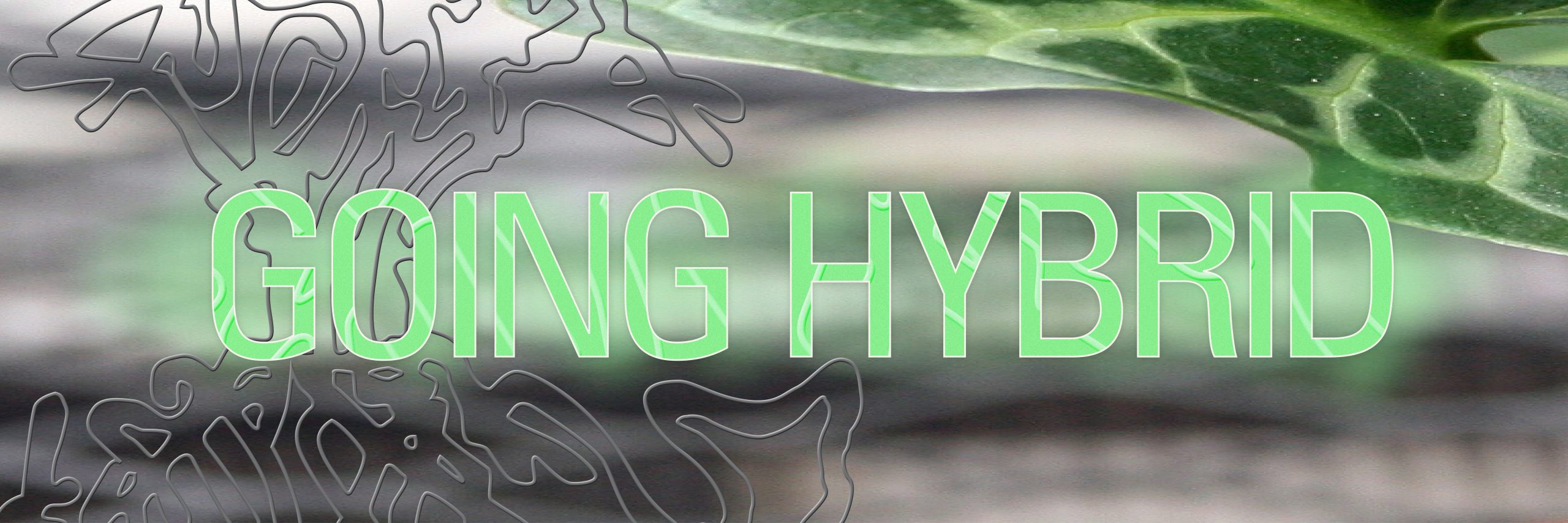How is the human body developing in response to our increased use of technology? How do we embrace our cyborgian nature in a communal way? Can we envision a truly hybrid future in which online participants are at the forefront, and not abandoned behind the screens?
“We are on the verge of a new evolutionary step – our transition into the hybrid human. This new body will be fully adapted to living simultaneously online and offline. For now, everything still feels uncomfortable and we are still getting used to having a digital presence alongside our physical one. Therefore Project Stargaze game was designed to experience the evolutionary process that lies ahead of us by providing a series of challenges for the physical and digital consciousness.
Project Stargaze is a new hybrid party game experience developed by Roos Groothuizen and Derk Over. “In this multi-team party game, participants pair up to help design the society of the future. One player in each pair is physically present in the space, while the other is online, connected to the game through a video call. Together they would form a single hybrid body that “physically” connects the online and offline players. How will they cooperate with their partners and the other duos to tackle the challenges of this new society?”
On a warm Sunday, the 21st of May, we gathered at IMPAKT in Utrecht. The game experience followed a speculative training format: a set of exercises to prepare the bodies for the hybrid future. I happened to be just a voyeur, observing the participants interact with each other and their online minds, struggle, laugh and explore their newly formed collaborative “bodies”.
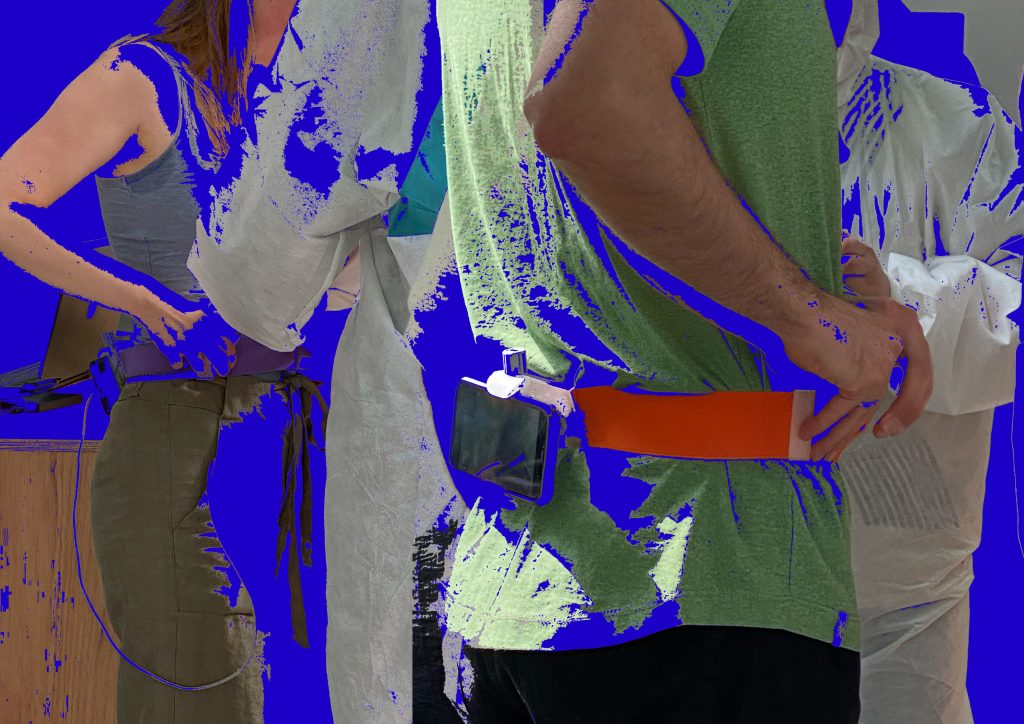
Upon entering IMPAKT, the players were welcomed by the host, Derk Over, in a full medical bodysuit. The outfit immediately invoked a not-so-distant pandemic past and created a techno-dystopian atmosphere. After checking the list of registered players, the participants were instructed to access the Zoom meeting from their phones. Once inside the Zoom space, they would have to put on elastic belts (each hybrid body had its own colour), which held their phones right above their asses. The host passionately reiterated the word ass which would make the participants laugh every time. Ironically the “physical bodies” were connected to the “online minds” through their asses. A chimaera of human experience.
The techno-dystopian atmosphere spread into the whole game experience. It took place in a large greenlit room, with instructions being projected on two opposing walls: an accessibility feature to involve the online minds, that resided above physical bodies’ asses. With soft ambient nature sounds playing in the background, it felt relaxing, like a “wellness room” in a large office building, which created an interesting contrast with the initial dystopian character.

The game consisted of a round of introduction, calibration exercises and three modules, from which the participants had to choose out of five different options. The calibration exercises consisted of communication, tilting and movement exercises aimed to calibrate the online
minds with their physical bodies. The awkward attempts of the physical bodies to tilt and move their asses in ways that would allow the online minds to perceive the environment were an enjoyable spectacle to me, a passive observer. The host would yell directions to the participants in the microphone, roughly interrupting the nature sounds with a loud whistle.
“Show the lowest green line to your online mind”
“Show the highest green line on the wall by tilting the camera with your hands”
“Follow the green zig-zag line on the floor while being directed by your online minds”
“The Human Experience of your online minds”
“The future depends on you!”, the coach exclaimed. The future is hybrid, and trans, boundary-elusive bodies are shaping the landscape. Then, the nature sounds stopped. The hybrid bodies now entered the Training Regime.
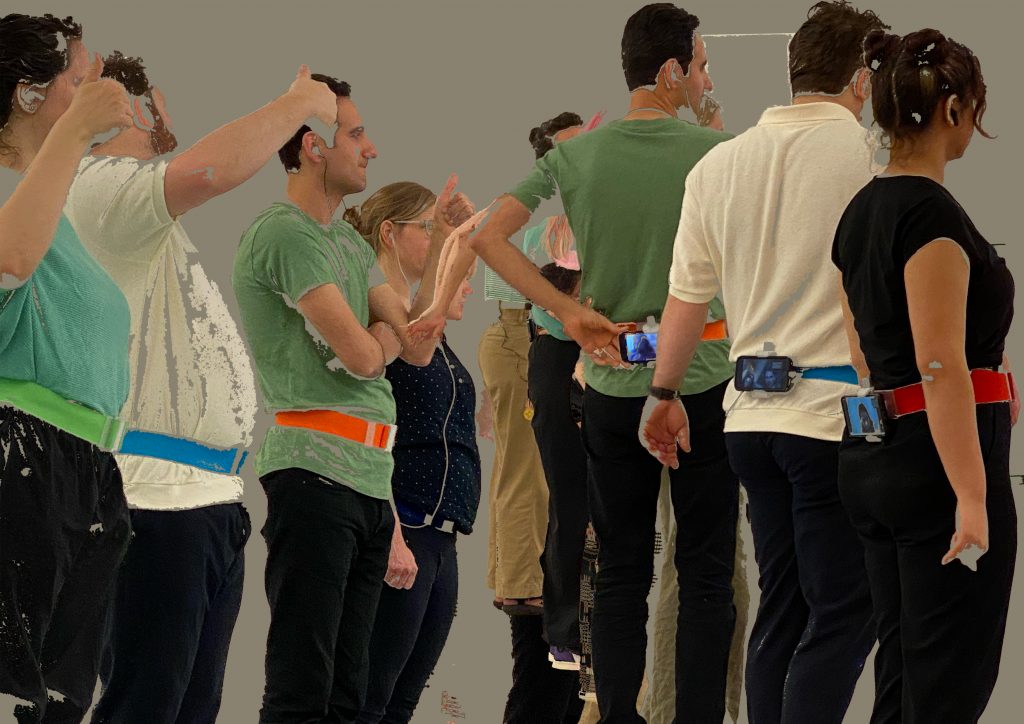
Module no.1: Creation
In the first module titled Creation, the physical bodies had to create an artwork, being guided by their online minds. The title for the artwork was communicated to each online mind through the Zoom chat. Everyone was given 3 minutes to complete their masterpieces on whiteboards attached to the walls on both sides of the room. It is weirdly calming to observe the physical bodies communicating with their online minds, in pursuit of creating a shared masterpiece.
The coach whistles angrily at the end of the round. Two sides of the room exchange positions. Each one is instructed to say “Aah!” while they are studying the artworks of their opponents.
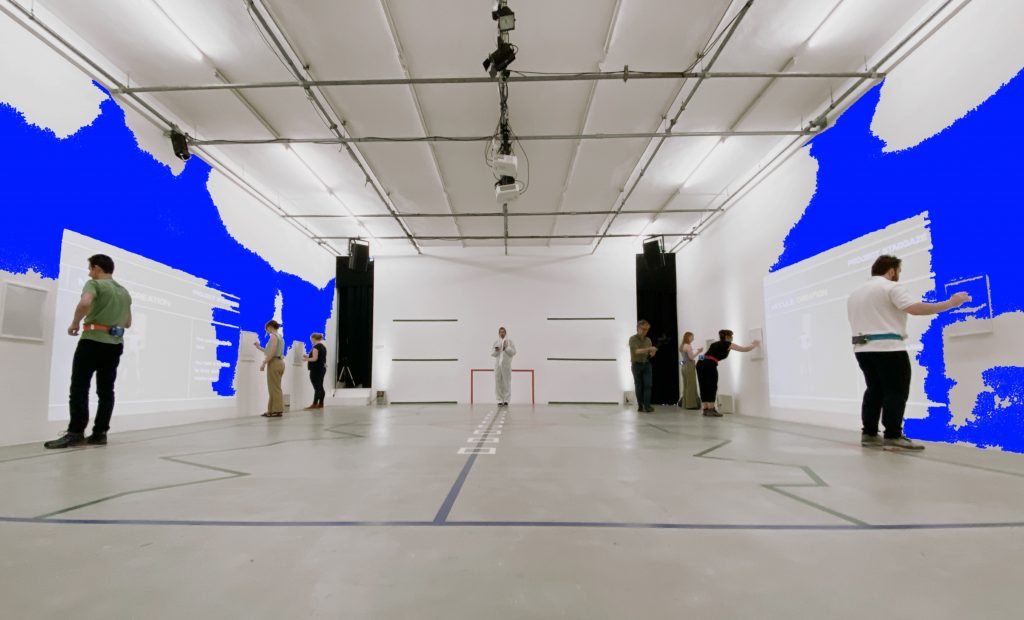
Module no.2: Competition
In the second module, the Competition module, the physical bodies had to compete against each other in what resembled hybrid football. Trying to direct the ball into the “red squares on the wall” while walking backwards, guided by the online minds. The awkwardness of having to navigate your body in new unusual ways naturally arose. Becoming aware of one’s own restrictions and affordances, and the process of becoming undone as one gives up control to their online mind, is always an intimate experience. This made the module an exercise of communal vulnerability. “Trophies are important” we were being told, but the experience was far from being competitive. It rather felt collective, on- and offline participants clumsily coming into unison in the pursuit of landing a large inflatable ball into the goal area.
The green belt won the round, with a score of 2. “The trophy is on the ass” the coach uttered, as he hung a medal on the phone, aka “online mind”. The participants then went on to repeat affirmations out loud, such as “We are hybrid and in touch with each other”. Thus echoing the format of affirmation memes, a memetic spin on “live, laugh, love” culture.
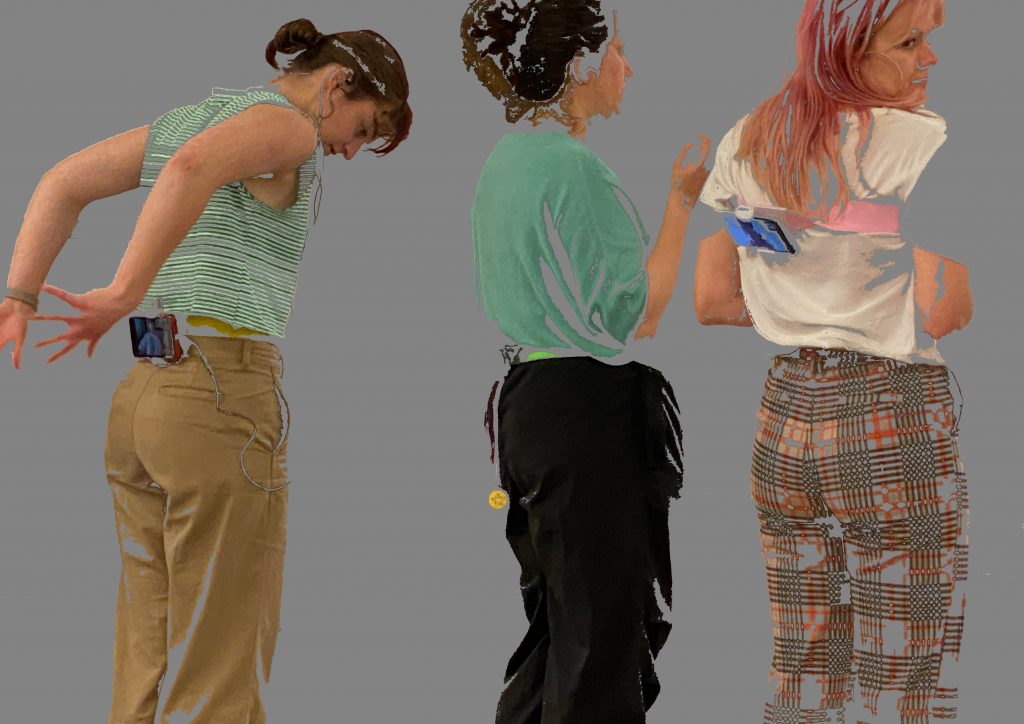
Module no.3: Construction
The lights changed to purple, drowning the gym in a lilac haze. The last module, titled Construction, focused on cooperative building. The online minds were provided with a part of a building plan of a tower. The physical bodies had to arrange coloured cubes on a square grid on the table, following the directions of their online minds. Technical issues kept arising throughout the process but were dealt with in a timely manner by Roos.
The physical bodies in collaboration with their online minds figured out their own ways of handling the cubes and assembling them into the tower. Some chose to show cubes and the physical plan to their “asses”, turning around to then comfortably place those cubes on the tower. Others instead took turns, keeping their online minds facing the building in progress, bending backwards, twisting their spines as they carefully tried to navigate the positioning of their cubes.
“Show your ass to the tower”

Upon the completion of the tower, the construction has been carried away by the hosts in full bodysuits, before doing another round of affirmations.
“Thank you I would really like to live with you in the future”
“You can now build houses for the future of humankind.”
“You are the Homo Nexus.”
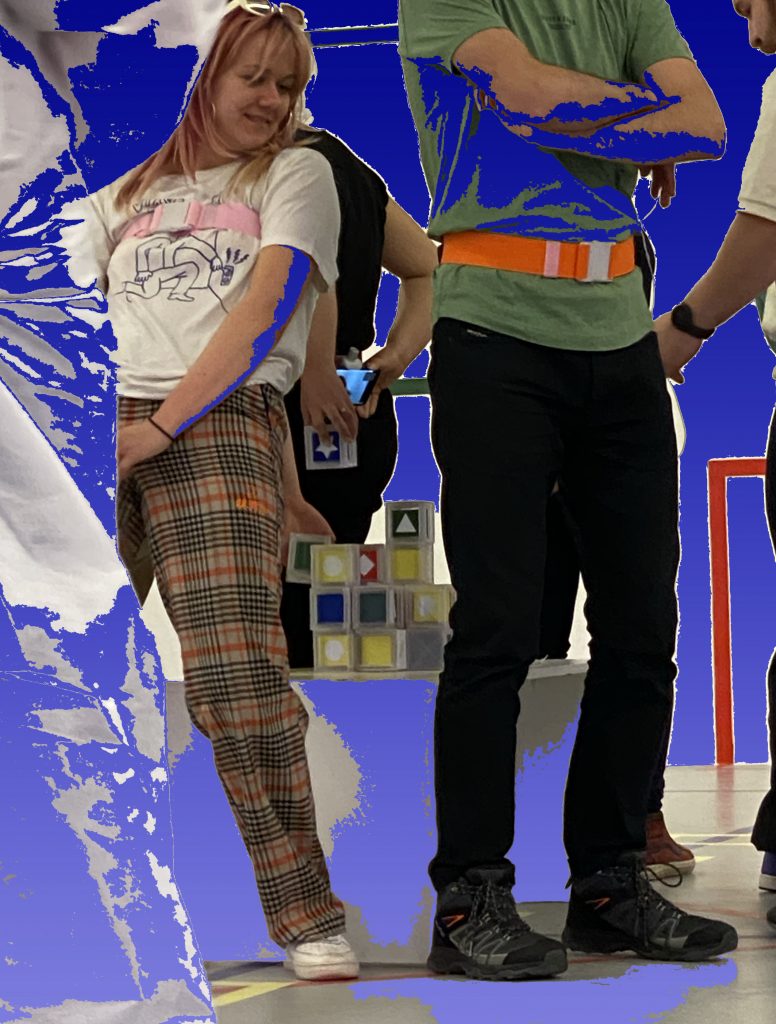
The training finished on such a positive note. The diplomas were given to all the newly formed and now fully functional hybrid bodies. Clapping was enforced.
Navigating tensions between extremities of a hybrid set-up: the present and the future, the individual and the communal, human and digital, online and offline. Walking on a thin line between techno-dystopia and utopia, balancing the two through humorous interventions, Project Stargaze was an immersive exercise in playfully embracing plurality. The experience allowed for the friction between the frontiers to shape the landscape of our present, rather than divulging into dualisms. While bringing the online audience to the front, and placing the offline participants in a secondary role, the game questioned our perception of embodiment and what it means to be a hybrid body in a post-pandemic world.


